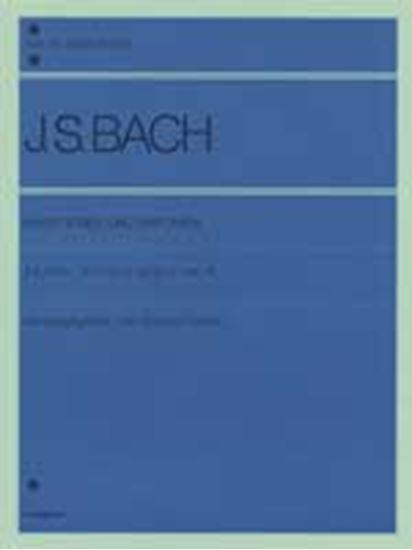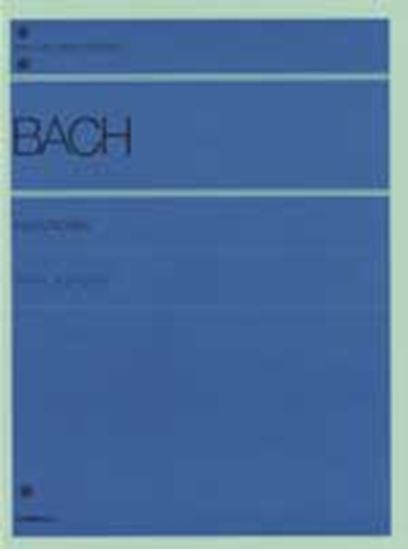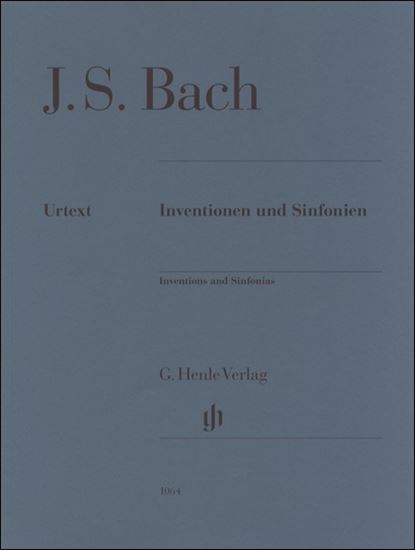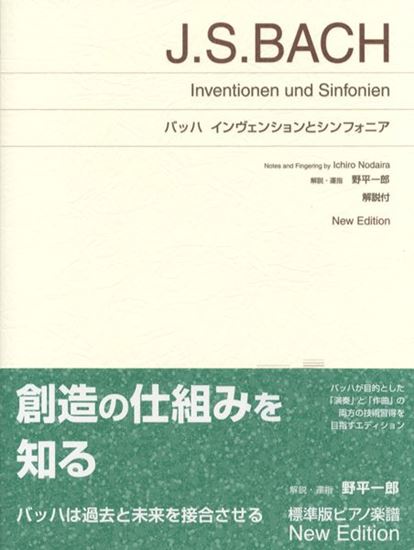Bach, Johann Sebastian : Sinfonia BWV 787-801
Work Overview
Publication Year:1801
First Publisher:Hoffmeister & Kühnel
Instrumentation:Piano Solo
Genre:pieces
Total Playing Time:20 min 50 sec
Copyright:Public Domain
Commentary (2)
Author : Asayama, Natsuko
Last Updated: May 1, 2007
[Open]
Author : Asayama, Natsuko
After compiling 30 works, Bach gave the name "Sinfonia" to a set of 15 three-part compositions. This has no direct relation to the genre, already established at the time, that originated from operatic overtures. Rather, it embodies the original meaning of the word: "blending in sound."
Most Sinfonias are written in fugal style, but none of them begin with the cumulative entry characteristic of fugues. (In the Inventions, Nos. 1, 2, 3, 4, 8, and 10 begin with a single voice.) This is thought to be for the purpose of developing short themes, suitable for pieces intended for study, as diversely as possible within a similarly short single piece, and also to avoid a harsh sound. However, some sections also employ triple counterpoint, and various combinations emerge through the inversion and retrograde of the themes.
Bach arranged these pieces to fit on a two-page spread, eliminating the need to turn pages during performance. The keys of the 15 pieces follow the same sequence as the Two-Part Inventions: C major, C minor, D major, D minor, E-flat major, E major, E minor, F major, F minor, G major, G minor, A major, A minor, B-flat major, and B minor. They were likely chosen considering their frequency of use in practice.
Please also refer to the section on "Inventions."
Author : Takamatsu, Yusuke
Last Updated: September 18, 2020
[Open]
Author : Takamatsu, Yusuke
General Overview
Like the Two-Part Inventions, the Three-Part Sinfonias are a compilation of short pieces composed by Bach as teaching material for his eldest son (see the section on "Inventions"). The music notebook Klavierbüchlein für Wilhelm Friedemann Bach, compiled by Bach from 1720, included works that would later become The Well-Tempered Clavier, Book I and the Inventions. The pieces now known as "Sinfonias" were originally titled "Fantasias" in this notebook, signifying creative and improvisatory pieces. They were renamed when compiled as an independent collection alongside the Inventions several years later. The term "Sinfonia" denotes an ensemble performance with multiple voices. Thus, from this new title, one can infer Bach's intention for the collection: to teach how to compose and perform in a way that allows three voices to resonate harmoniously.
Naturally, the Sinfonias share the same objective as the Inventions: to correctly master both composition and performance techniques. The 15 pieces follow the same key progression as the Inventions, ascending the scale from C major (the order of pieces was changed from the original Klavierbüchlein). However, compared to the Inventions, the Sinfonias contain a significantly greater number of fugue-like pieces employing counterpoint, demanding more advanced compositional and performance skills.
Bibliography
- Ichida, Giichiro. 1971. Bach: Inventions and Sinfonias. Tokyo: Ongaku no Tomo Edition.
- Higuchi, Ryuichi et al. 1996. The Complete Works of Bach, Vol. 11: Harpsichord Works [1]. Tokyo: Shogakukan.
- Isoyama, Tadashi, Yoshitake Kobayashi, and Fumio Narumi (eds.). 1996. Bach Encyclopedia (Complete Works Commentary). Tokyo: Tokyo Shoseki.
- Geck, Martin. 1998. Great Composers: Bach. Translated by Kinya Osumi. Tokyo: Ongaku no Tomo Edition.
- Kokaji, Kunitaka, and Masako Nakai. 2005. Bach: Sinfonias – A Guide to Analysis and Performance. Tokyo: Chopin.
- Küster, Konrad (ed.). 1999. Bach-Handbuch. Bärenreiter & J. B. Metzler.
No. 1 in C Major, 4/4 Time
This piece is fundamentally structured by flowing sequential progressions of sixteenth notes, making it suitable for mastering the "cantabile style of playing" as noted by Bach in his preface. This scale-based subject appears in various keys and forms (inversion), combining and creating undulations. This avoids clear sectional divisions, and it has been noted as an "archaic style of writing with intricate development and structure."
The overall structure can be divided into four exposition sections: the first exposition (m. 1–) and the first half of the second exposition (m. 8–), and the second half comprising the third exposition (m. 12–) and the fourth exposition (m. 16–).
No. 2 in C Minor, 12/8 Time
The subject consists of two measures: an arpeggiated chord (m. 1) and a sequential progression including a diminished seventh leap (m. 2). The entire piece is clearly structured in two parts. In the first part, the upper and middle voices present the subject in C minor (m. 1–), and the lower and upper voices present it in G minor (m. 9–).
A distinctive feature of the second part (mm. 19–32), which begins in G minor, is that the subject never appears in its complete form. Only the arpeggiated chord portion corresponding to the first measure of the subject is primarily used. This arpeggiated motive is combined with the transitional sixteenth-note motive seen in m. 8, among others, leading to successive modulations through sequential progressions.
No. 3 in D Major, 4/4 Time
Although it has a bright, dance-like character, it is structured as an advanced fugue with two countersubjects, following this form: First Exposition (m. 1–) — Interlude 1 (m. 8–) — Second Exposition (m. 10–) — Interlude 2 (m. 12–) — Interlude 3 (m. 14–) — Third Exposition (m. 19–).
In the first exposition, the subject entry moves from the upper voice to the lower voice, and two countersubjects are combined with the subject. In the third exposition, contrary to the beginning, the subject entry moves from the lower voice to the upper voice, and the two countersubjects are arranged with the subject in a different combination than in the first exposition.
m. 1 | m. 3 | m. 5 | m. 19 | m. 21 | m. 23 |
Subject | Countersubject 1 | Countersubject 2 | Countersubject 1 | Countersubject 2 | Subject |
Basso Continuo | Countersubject 2 | Subject | Subject | Countersubject 1 | Countersubject 2 |
The following lists illustrate the entries of the subject and countersubjects:
- m. 1: Subject
- m. 3: Countersubject 1
- m. 5: Countersubject 2
- m. 19: Countersubject 1
- m. 21: Countersubject 2
- m. 23: Subject
Combinations of elements:
- Subject, Countersubject 1, Countersubject 2
- Subject, Countersubject 1, Basso Continuo, Countersubject 2
- Subject, Subject, Countersubject 1, Countersubject 2
Although the second exposition is brief, the upper voice presents the subject in the parallel key of B minor, while the middle voice plays countersubject 2 and the lower voice plays countersubject 1. This demonstrates a combination pattern that was missing in the first exposition due to its initial placement.
No. 4 in D Minor, 4/4 Time
Written as a fugue, a characteristic feature of the subject's "inventio" (invention/idea) is the tied suspension. Suspensions are not only used as part of the subject but also motivically in sequential progressions, dominating the entire piece.
At the beginning, when the upper voice presents the subject in D minor, the middle voice responds in the dominant key from m. 2. This is a technique called "stretto," where the next entry overlaps before the preceding subject is complete. From m. 13 onwards in the second part, all voices—upper, middle, and lower—present the subject in stretto.
In the middle voice at mm. 12–13 and the upper voice at mm. 22–23, a descending chromatic motive is combined. This is a figure frequently used to express sorrow, known as "passus duriusculus," and it imparts a distinctive character to the piece.
No. 5 in E-flat Major, 3/4 Time
The lower voice functions as an ostinato bass, repeating a fixed melodic figure, which evokes a trio sonata consisting of two principal voices (obbligato) and a basso continuo. The two principal voices, at first glance, seem to play freely over a consistent harmonic support, but the middle voice imitates the upper voice, revealing that the piece is written with extensive use of counterpoint.
The entire piece is structured in two well-balanced parts, with the second part beginning at m. 17.
No. 6 in E Major, 9/8 Time
It features a "cantabile" subject based on sequential progression. The first half of the piece (mm. 1–18) consists of two exposition sections. In the second exposition (m. 11–), a new harmonic and dance-like subject is devised based on the third beat of the original subject.
A flowing eighth-note rhythm resonates throughout the piece in one of the voices, but there are two instances at the end of the piece where this "filling rhythm" breaks. First, at m. 34, the flow is halted by a fermata—with a dissonant effect—marking the beginning of the coda. Then, after creating a decelerating effect with improvisatory and ornamental sixteenth notes at m. 38, the piece concludes.
No. 7 in E Minor, 3/4 Time
It possesses an "arioso"-like character, intermediate between recitative (speech-like) and aria (song-like). Although written in a contrapuntal style, its relatively free structure reveals the character of "Fantasia," the original name for "Sinfonia."
It consists of four exposition sections. After the initial first exposition, the second exposition (m. 14–) features the subject entering in the reverse order of the first exposition (middle voice → upper voice), and a new countersubject is combined. At the beginning of the third exposition (m. 25–), the key of D major and the rest in the lower voice announce the start of the second half of the piece. After the subject is presented without interruption, it returns in the tonic key at m. 37 (fourth exposition). Here, all three voices seem to overlap in presenting the subject, emphasizing the concluding section.
No. 8 in F Major, 4/4 Time
Sinfonia No. 8, positioned at the center of the 15 Sinfonias, has a contrasting character to the surrounding pieces. Despite its lively character, it is notably constructed with strict counterpoint. It consists of four exposition sections and three interludes.
The concise one-measure subject presented at the beginning is introduced in the order of middle voice – upper voice – lower voice. It is then exceptionally re-presented in the dominant key (mm. 5–7), separated by the first interlude (mm. 4–5) which uses the opening motive of the subject. In the latter half of m. 7, the middle voice rests, signaling the beginning of a new second exposition. Here, the upper and lower voices first form a stretto and modulate through sequential progression (m. 7–), while the previously resting middle voice joins in G minor and develops (m. 11–). Following the relatively short second interlude (mm. 15–17), the third exposition (mm. 17–19), and the third interlude (mm. 19–20), the subject returns in the tonic key in the lower and upper voices at m. 21, concluding the piece.
No. 9 in F Minor, 4/4 Time
Similar to No. 3, this piece is constructed using triple counterpoint, where the subject is combined with two countersubjects. The subject presented by the middle voice at the beginning not only expresses a sigh-like character through rests and a descending second, but countersubject 1, placed in the lower voice, is based on the "passus duriusculus" (a chromatic descent of a fourth), which was used to express suffering and sorrow. Furthermore, the subject includes a tritone leap (beginning of m. 2), which is the most dissonant interval, emphasizing the lamenting character of the piece.
In the first two measures, the upper voice rests, resulting in a two-voice texture. However, from m. 3, in the subject exposition, the upper voice takes the subject, the middle voice takes countersubject 1, and the lower voice introduces a new countersubject 2. The subject is presented 10 times throughout the piece, but in all 9 instances except for the opening, it is always combined with two countersubjects. The piece is structured approximately symmetrically, with the 4th-5th and 7th-8th appearances of the subject occurring in major keys.
No. 10 in G Major, 3/4 Time
A bright piece in G major. Like No. 1, the subject is constructed from sixteenth-note scales. The subject is presented by the upper voice in mm. 1–2, after which the middle voice responds in mm. 3–4. In m. 5, the middle voice seems to repeat the subject, but in fact, it deviates from the subject with a continuation of eighth-note arpeggiated chords in m. 6, which becomes a characteristic motive for the interlude.
What the middle voice plays in m. 11 is a variation of m. 5, which functioned as an interlude. However, the subsequent two measures are not eighth-note arpeggiated chords but the latter half of the subject, revealing that mm. 11–12 constitute a subject exposition (second exposition). Thus, a characteristic feature of this piece is its development with an ambiguous distinction between subject and interlude.
No. 11 in G Minor, 3/4 Time
A lyrical piece, as if perfectly suited for mastering "cantabile" playing. This lyricism is underpinned by the relatively long subject and the dissonant sounds created by suspensions.
The subject presented at the beginning is relatively long, spanning eight measures, and is centered around a descending G minor scale (m. 1: G, m. 2: F, m. 3: E-flat... m. 6: B-flat, m. 7: A). The countersubject in the middle voice, combined with this, is tied from the third beat, designed to create a dissonant sound on the first beat of the next measure and resolve on the third beat. This continuous succession of dissonance-to-resolution dominates the entire piece, creating a unique lyricism. Furthermore, the opening part of the subject is repeatedly used as a principal motive.
No. 12 in A Major, 4/4 Time
It has a bright and charming character, written in a fugal style. At the beginning, the middle voice rests, while the upper voice plays the subject and the lower voice plays the countersubject. This countersubject is then varied in various ways and combined with the subject. The subject includes a pedal point on the dominant at the beginning of m. 2. When this motive is used repeatedly on its own, the lower voice functions as a relatively long pedal point (e.g., from m. 9–).
The entire piece is divided into two parts, but in the second half (m. 15–), the complete subject appears only three times, with the section primarily dedicated to the development of material contained within the subject.
No. 13 in A Minor, 3/8 Time
A fugal piece based on a concise subject derived from sequential progression. At the beginning, the middle voice responds to the upper voice's subject at the fifth above (m. 5–), and the lower voice also presents the subject (m. 13). Following Interlude 1 (mm. 16–20), the second exposition (m. 21–) alternates between C major and A minor through the inversion (i.e., exchange) of the upper and middle voices. Here, a new countersubject based on an arpeggiated chord is presented by the lower voice, determining the piece's progression.
Furthermore, in Interlude 2 (mm. 36–40), a new motive including thirty-second notes appears, forming sequential progressions accompanied by imitation between voices. This motive is basically used only in the interludes, but following the third exposition (mm. 41–55) and Interlude 3 (mm. 56–60), when the subject is presented again at the end of the piece, this interlude motive is combined as a countersubject (m. 60–).
No. 14 in B-flat Major, 4/4 Time
Written in a fugal style, it consists of a first half (First Exposition: m. 1–, Second Exposition: m. 7–) and a second half (Third Exposition: m. 12–, Fourth Exposition: m. 15–).
A characteristic feature of this piece is the frequent use of "stretto." Stretto refers to a technique where the next subject entry overlaps before the preceding subject is complete. Already in m. 3 and m. 6, the lower voice can be seen entering in an overlapping manner against the upper voice. While these are part of the interludes, stretto of the subject itself is observed in the second half.
In the second half, the middle voice forms a stretto against the upper voice, first delayed by one beat from m. 12, and then by a half beat from m. 17. And from m. 20, the final subject exposition, all three voices—middle, then upper, then lower—present the subject in stretto, forming the climax of the piece.
No. 15 in B Minor, 9/16 Time
A piece in a free, capriccio-like style. Similar to the Inventions, but particularly in the Sinfonias, where strict fugal pieces are prevalent overall, the light character of this piece at the end of the collection creates an element of surprise. If this element of surprise is considered a form of humor, then this piece is indeed fitting for a capriccio.
It largely consists of two parts. The first part (m. 1–) and the second part (m. 14–) are followed by a coda (m. 35–), with interludes interspersed between each section. Before the coda, a pause indicated by a fermata is placed at m. 32, suggesting the possibility of a cadenza. And at the very end of the piece, "Finis" is written, explicitly stating that with this, the series of "proper instruction" that began with the Inventions has concluded.
Movements (15)
PTNA & Partner Channel Videos(36items) View More
Sheet MusicView More
Scores List (61)

カワイ出版

(株)ヤマハミュージックエンタテインメントホールディングス

(株)全音楽譜出版社

(株)全音楽譜出版社

(株)ドレミ楽譜出版社

(株)音楽之友社

(株)全音楽譜出版社

(株)音楽之友社

(株)音楽之友社

(株)ドレミ楽譜出版社

(株)ドレミ楽譜出版社

(株)ドレミ楽譜出版社

(株)ドレミ楽譜出版社

(株)全音楽譜出版社

ヘンレー

ヘンレー

カワイ出版

(株)渓水社

(株)音楽之友社

(株)全音楽譜出版社

(株)エー・ティ・エヌ

(株)全音楽譜出版社

カワイ出版

(株)音楽之友社

(株)音楽之友社

ヘンレー

ヘンレー

(株)全音楽譜出版社

(株)ドレミ楽譜出版社

(株)学研プラス

Musikverlag Doblinger


















































